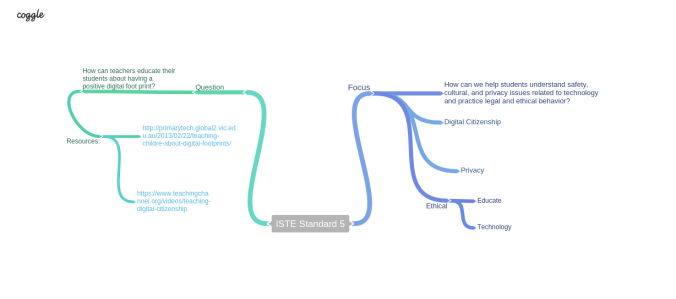ISTE 5 Focus: How can we help students understand safety, cultural, and privacy issues related to technology and practice legal and ethical behavior?
Question: How can teachers educate their students about having a positive digital foot print?
Incorporating technology into the classroom can be such a wonderful tool for students, but it can also come with many challenges. It is crucial that teachers educate their students on the importance of creating a positive digital footprint. Many students can’t yet grasp that the information and images they share on the internet, have the potential to stay with them for a lifetime. Once someone shares something on the internet, it turns into public property. Teachers need to ensure that their students have a solid understanding of the backlash that this can have. While there are many scary things that can happen, the article that I looked at this week showed how one teacher was focusing on the positives of digital foots prints.
In the article Teaching Children About Digital Footprints, the author looked at how to educate students about creating a positive digital footprint. The article was written by a teacher expressing her views on the topic. Her feeling was that many teachers try and scare their students with all of horrors that can take place on the internet. She instead found it useful to encourage her students to explore the ways that they can create a positive digital footprint. In the article it stated that, ““I can see a day in the not too distant future … where your ‘digital footprint’ will carry far more weight than anything you might include in a resume or CV” (Morris, 2013). She wanted her students also to be aware that everything they put on the internet should be carefully considered, because it could have lasting effects on their adult life.
I was interested to see how teachers educate younger students about this topic. I found a video of a 5th grade teacher, teaching a lesson about the importance of being a digital citizen. https://www.teachingchannel.org/videos/teaching-digital-citizenship, in this video the teacher asks his students to share what they think some possible ways are, that a person could be irresponsible on the internet. He also asks them how they think they can have a positive presence on the internet. It is so important that teachers start educating their students about this topic young, since technology is ever growing.
Resources:
Morris, K. (2013, February 22). Teaching Children About Digital Footprints. Retrieved August 9, 2015, from http://primarytech.global2.vic.edu.au/2013/02/22/teaching-childre-about-digital-footprints/
Super Digital Citizen. (n.d.). Retrieved August 9, 2015, from https://www.teachingchannel.org/videos/teaching-digital-citizenship

Sarah – I enjoyed reading your blog post, and I like turning around the possibility that digital footprints are always negative. It seems like that’s what you hear in the media. Teaching students that they can have a positive footprint is really valuable and a very appropriate life skill as well. Thanks for posting!
LikeLike
Hi Sarah,
I like that you discussed how students don’t realize the lasting impact of what they post online. I think it’s very true. Without guidance and education on the issue, I’m sure many students would not consider the big picture, long term effects. I like that the teacher you mentioned chose to take a more positive angle and re frame the issue in a different way rather than using scare tactics. Explaining to the student why it is important rather than scaring them is more effective and meaningful. I enjoyed reading your thoughtful post!
LikeLike
Hi Sarah,
Thank you so much for your post. I think that teaching students that their digital footprint can be positive is so important. Scaring them might turn them away from technology. That should not be our objective. Students need to use good judgement, but scaring them from participating in the world around them is not productive. Instead we should help students see their potential to make positive changes in the digital world. Thanks for bringing this to light; so often we teachers get distracted by the dangers and forget that students are bright and so capable of igniting amazing change.
LikeLike